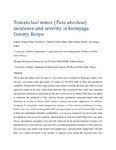Tomato leaf miner (Tuta absoluta) incidence and severity in Kirinyaga County, Kenya

View/
Date
2019-04Author
Nderitu, Wangari Peris
Wafula, Geoffrey O.
Otieno, Mark
Metadata
Show full item recordAbstract
The tomato leaf miner (Tuta absoluta) is a new insect pest of tomato in Kirinyaga County. Tuta
absoluta can reduce yield and quality of tomato by 80-100% both in field and greenhouse
conditions. Farmers have been using synthetic insecticides to combat the insect pest. However, the
aggressive nature of the pest, multivoltine character, short generation time, high biotic potential
and increased resistance to insecticide use has led to difficulty in its control. This study was aimed
to determine the incidence of Tuta absoluta through monitoring using pheromone traps and
determine its severity in tomato fields’ despite chemical insecticides applications for effective
designing of ecologically-sound management strategies of Tuta absoluta in Kirinyaga County.
Field survey was carried out during 2016-2017 growing seasons on a set of 15 tomato fields located
in three sites (Kimbimbi, Defathers, and Kariithi). A survey was conducted every three weeks from
transplanting to harvest on 30 randomly selected plants in each focal field. Three leaves per plant
(lower, intermediate and upper) were carefully inspected for the presence/absence of mines. Sex
pheromone traps were used in every focal field to monitor population dynamics of Tuta absoluta.
Tuta absoluta trap catches were found in all sampled sites, captured moths ranged from 120-240,
there was a linear increment in the number of captured moths during the surveyed time. Tuta absoluta mining damage on the leaves was observed in all the 15 focal fields. High infestation was
recorded on the lower part of the leaf (73%) at 100 days after transplant. Upper part of the leaf
recorded the lowest damage of Tuta absoluta among the three sites sampled. Kariithi showed the
highest (37%) infestation compared to other sites. Infestation damage increased as the crop
advanced in growth and was heaviest at the end of the cropping cycle. Synthetic insecticides have
been found to reduce populations of naturally occurring predators and parasitoids of Tuta absoluta
and increased development of resistant populations of the insect pest. It is therefore imperative to
develop alternative nonchemical integrated control programs for a sustainable management of T.
absoluta.
